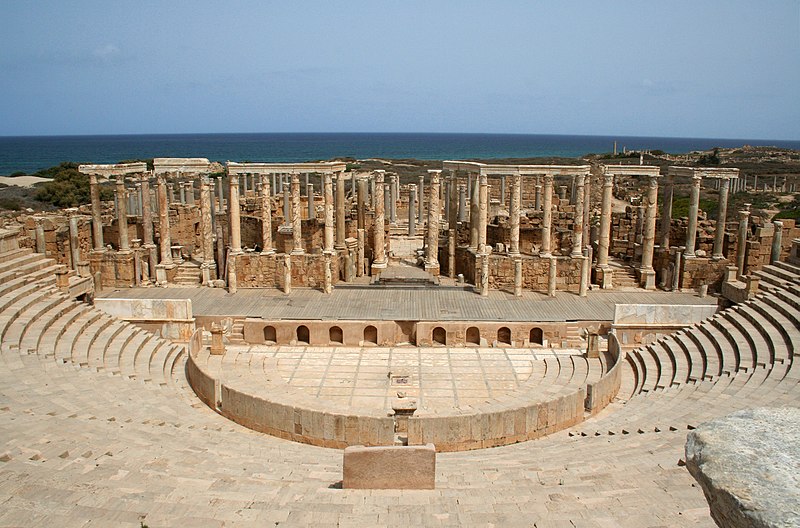Leptis Magna Facts for Kids
Leptis Magna is an ancient city in modern-day Libya, famous for its well-preserved Roman ruins and rich history as a key trading hub in the Mediterranean.
View Article For:

Related Articles
Introduction
️ This city was famous in ancient times for its beautiful buildings and busy markets! It was near the Mediterranean Sea, which is a big body of water. Leptis Magna was part of the Carthaginian Empire, where people traded goods like olive oil and pottery. 🍶
It became very important when the Romans took over. It was known for its grand architecture, making it a special place for visitors at that time.
History And Founding
It was established by the Phoenicians who came from a place called Tyre in modern-day Lebanon. They built it around 1000 BC. The Phoenicians loved the ocean, so they chose a spot near the sea! ⛵
As time passed, Leptis Magna became part of the Carthaginian Empire. The Romans later took control in 46 BC, and Leptis developed into a very important Roman city. A famous emperor named Septimius Severus was born there, adding to its fame! 👑
Cultural Significance
The city brought together different people like the Phoenicians, Romans, and local Libyans. These groups shared traditions, languages, and beliefs. Festivals were held to honor various gods. 🎉
Art and music flourished, leading to beautiful mosaics and sculptures. Food was also important, with delicious Mediterranean dishes being prepared. People would gather to trade and celebrate, strengthening their community ties. Leptis Magna was not just a city; it was a lively hub of culture and diversity.
Inhabitants And Society
They included Phoenicians, Romans, and Berbers, each contributing to the city's culture. Families lived in stone houses, and they enjoyed a variety of food, music, and festivals. 🎶
Children played games like ball and hopscotch, while adults worked as merchants, farmers, or artisans. The society valued education and learning, with schools for children. People were proud of their city and participated in community events, making Leptis a great place to live!
Architectural Highlights
️ One of the most impressive structures is the Roman Theater, which could hold about 5,000 people. Imagine watching plays or concerts there! 🎭
There’s also a large marketplace called the Forum, surrounded by columns and statues. The Arch of Septimius Severus stands tall as a beautiful monument. 🏹
These buildings were made from local limestone, which made them strong and long-lasting. The city's architecture combined Greek, Roman, and local styles, creating a unique look!
Influence On Modern Libya
By protecting sites like Leptis Magna, people honor their past while looking toward the future. The city reminds us that history is alive and shapes our present! 🌟
Archaeological Discoveries
They found beautifully preserved buildings, mosaics, sculptures, and pottery. These discoveries help us learn about how the people lived. For example, colorful mosaics showed scenes of nature and daily life, giving us a glimpse into their world. 🌼
Important artifacts like coins also tell stories about trade. By studying these finds, archaeologists piece together the history of Leptis Magna, making it one of the most important archaeological sites in Libya! 🏺
Economic Importance In Antiquity
It had access to the Mediterranean Sea, allowing goods like oil, grain, and textiles to be exchanged. Traders came from all over the region, creating wealth for the city. 🏦
Leptis also produced many items at its workshops, including pottery and jewelry. With its rich agricultural land, the city could feed many people, making it economically strong. The Romans even made it a part of their empire to benefit from its resources! 🌾
Geographic Location And Environment
Near a river called the Wadi Lebda, which provided fresh water, the city was in a place full of natural beauty. 🌳
The area has warm summers and mild winters, perfect for farming. The rich soil allowed people to grow crops like grapes and wheat. It’s also a beautiful spot with beaches, cliffs, and palm trees, making it a fantastic place for people to live and trade with others. ☀
️
Preservation And Restoration Efforts
️ Organizations like UNESCO help to preserve these ancient treasures because they are part of human history. Restoration efforts include repairing broken columns and cleaning mosaics. 🌟
Visitors come from all around the world to explore this amazing site, so it is essential to keep it in good shape! The goal is to ensure future generations can learn about and appreciate the beauty and history of Leptis Magna too! 🧭
Impact Of Leptis Magna On Roman Trade
Its port allowed goods from Africa to be shipped all over the Roman Empire. People traded products like olive oil, grains, and luxurious textiles. It became a major stop on trade routes, connecting Africa with Europe and beyond. The city's prosperity brought wealth to Rome and boosted the economy! 💰
Leptis Magna's marketplaces buzzed with activity as merchants and traders exchanged products, ideas, and culture, making it a central part of the Roman trading network.
DIY is a humongous library of
activities and courses for kids.
Curious?
Gallery of
Did you know?
🏜️ Leptis Magna was an important city located in what is now Libya.
🍶 The city was famous for trading goods like olive oil and pottery.
🌍 Its history dates back over 2,500 years, founded by the Phoenicians around 1000 BC.
⛵ The city was strategically located near the Mediterranean Sea.
👑 A famous Roman Emperor, Septimius Severus, was born in Leptis Magna.
🌊 Leptis Magna was known for its stunning architecture, including a Roman Theater.
🏛️ The city had a large marketplace called the Forum, surrounded by beautiful columns.
🌐 Leptis Magna was a melting pot of cultures, including Phoenicians, Romans, and locals.
🚢 It became a crucial center for trade in the Roman Empire.
🏗️ Today, efforts are ongoing to preserve the ancient ruins of Leptis Magna.










